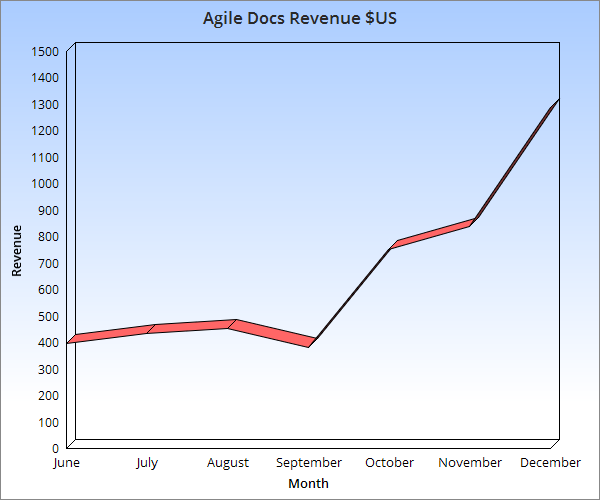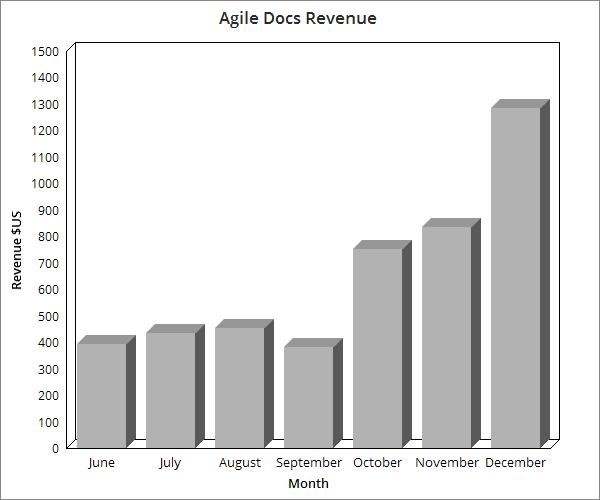It’s now been six months since I launched Agile Docs, an app that helps Program Directors get a big-picture overview of how their teams are progressing in Jira on a single page.
In that time, revenue has slowly increased to US $1285 MRR. That’s my cut for the month after Atlassian’s 25% fee. Gross revenue not including Atlassian’s fee would be US $1713 MRR.
My only costs are my email provider ConvertKit, G Suite for my Agile Docs email address, Heroku for hosting the app and Papertrail for keeping track of server logs. This is around US $120 in total, though I don’t expect this to increase very much over time.
I’ve yet to spend anything on marketing. I’ve relied mainly on forum posts where people are complaining about the lack of availability of a specific feature. Often these forum posts have been at the top of search results for keywords related to my app. The Atlassian Marketplace has also been driving a steady increase in the number of new trials each month.
The First 3 Months After Launch: June to August
The first few months were very slow. The first iteration of the product was buggy and lacked a ton of features. But over those months I collected as much customer feedback as I could.
I managed to start conversations with a handful of users starting new trials who were kind enough to let me know where Agile Docs was falling short for their use case. Occasionally this meant a few must-have fixes to even make it useable. They’d also share some features they’d like to see in the future which would be useful for them.
I set up better tracking mechanisms to see where users were encountering errors so I could be proactive if I noticed something was off. I found Sentry and Papertail very helpful for this.
Slowly, I fixed any obvious bugs users were encountering and modified the product to accommodate a broader range of use cases. There was no magic bullet during this period. Instead, I focused on getting the product to a useable level for most people starting a trial.
Some of the key improvements included:
- Fixing any bugs causing the app to crash
- Making the app useable on larger Jira instances with more than 100+ Epics
- Supporting classic project types in addition to next-gen projects
- Allowing more flexibility in the issue hierarchy
- Creating an in project view as well as a global view
- Modifying the UX so users could avoid potentially unwanted actions, such as deleting a project
- Setting up a cron job to collect the emails of new trials
These were largely unglamorous changes. They were kind of teething issues you’d expect for a new app just getting to the point where it can actually deliver on what it promises.
Traffic came in mainly through the Atlassian Marketplace. There’s a period right after you launch your app where it is listed in the free section of the Atlassian Marketplace. This gives you a temporary boost in traffic. In addition, I had a handful of forum posts that drove a modest amount of traffic that I’d set up when validating the idea.
The conversion rate of free trials to paid was very low during this period. What kept me going was the handful of customers who converted and the influx of new trials with zero marketing spend. This gave me the confidence to continue improving the product and seeing how the next batch of trials converted.
The Inflection Point: September to December
Both my conversion rate from trial to paid and the number of new trials coming in improved the most in this period. It’s reflected in the steady increase in revenue from September onwards.

There were a number of small improvements to the product during this time which no doubt influenced these metrics. But the biggest needle movers were select features that both added value to existing customers and opened up a new acquisition channel.
In practice, this meant that at least one existing customer had requested feature x, and there were also 4-5 forums where people were complaining about not being able to do x. Once I added feature x, my existing customers were happier and less likely to churn. And now I could post in the 4-5 forums where people were requesting feature x. Those forums would send an email alert to everyone who commented on the forum about my post. And they’d continue to send a consistent stream of traffic to my app every month.
As an example, I had a customer request to be able to see the story point progress of an Epic based on the progress of its child issues. There were a number of forums where people were complaining about not being able to do this. I added the feature. The customer I responded to was very happy, and I was able to post on a number of forums about this which brought in more new trials in the following months.
Some of the features which opened up new acquisition channels for Agile Docs included:
- Tree view of all issues in a project or release
- Rolled up Epic Story Point Progress Reports
- Rolled up Time Tracking Epic Progress Reports
- Quick filters for zooming in on any team or set of issues
It was during this period that I began to get an idea of what my most valuable customer segment was. I identified that 80% of my revenue was coming from just 20% of my customers. The Pareto principle was guiding my revenue numbers.
My users fit into two primary categories:
- Program Directors in companies with 100-500 employees trying to get an overview of how their teams are going. These users primarily want more robust reporting and features which give them useable insights into what teams need their attention.
- Agencies who want an efficient way to create new projects and get them into Jira. These users want features to more easily get their product requirements into Jira.
A few months after launch it became apparent that the bulk of my revenue was coming from the former group. And the fastest way to keep it increasing was to make sure the reporting functionality was as great as possible.
From then on, before working on a new feature I’d ask the questions:
- Will this feature add value to my most valuable customer segment and if so, how much?
- Will this feature open up at least one new acquisition channel?
- How much work is this feature?
I’d prioritize features based on their impact across those three axes.
Revenue grew steadily from US $381 in September 2019 to US $1285 in December 2019 but psychologically, this period felt fast-paced and chaotic. I was adding features at a frantic rate.
I had to remind myself several times that when a new trial cancelled it wasn’t the end of the world. Maintaining a consistent meditation practice helped. I’d meditated daily for years, but recently I’ve bumped it up to twice a day. Reading books on stoicism also helped.
I’m looking forward to continuing to work on Agile Docs in 2020. Though I’m unsure of what, if anything, it will ultimately become, I think it’s shown enough promise to suggest there is a market for it. I’m interested to see what successes and challenges 2020 will bring.
